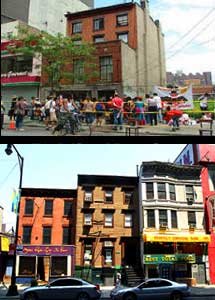
Fort Greene is a booming neighborhood, with new residents moving into renovated buildings, and new developments going up every minute...
...unless your landlord happens to be the NYC Housing Authority. If you pay your hard earned income to NYCHA, then you face a very uncertain future, and your situation looks a lot like the residents of Brownsville. Here's how the Village Voice starts their article on it in "Bringing Down the House":
On the surface, Fort Greene's public housing projects look like an example of good government. Late last week, a gaggle of workers in hard hats carried pipes on their shoulders to one of the towers, and the sound of a buzz saw occasionally broke the silence. As part of a $150 million modernization at the 60-year-old Walt Whitman and Raymond V. Ingersoll Houses, the workers were replacing counters, appliances, and elevators for thousands of low-income residents.
This sounds hopeful, right? Unless you compare it to the history of the Prospect Plaza houses in Brownsville. The residents there were promised a sparkling new renovation, but the buildings that used to house at least 1,100 have been left empty, except for a security guard or two.
It's a pretty brutal comparison. Huge new luxury condos going up just a few feet away from buildings that are being emptied out.
Oh, and if you think that the $150 million modernization budget in Fort Greene sounds like a good sign, look again. A November 2006 report says that there is $48.5 million on the City budget to repair the Prospect Plaza buildings. And that's different from the $175 million for repairs as part of the Hope VI program. That program never got beyond Phase 1. In any case, that's quite a pretty penny to pay for the two security officers guarding the rotting NYCHA buildings.
There are millions of dollars on the budget for our government to fix up the NYCHA properties. But the City (with the help of the state and Feds), have decided to be really bad landlords. Instead, they spend their money (actually, isn't that supposed to be OUR money?) on subsidizing rich developers, and spending untold amounts on eminent domain procedures to remove the Duffield Street landowners.
The residents of Prospect Plaza were promised improved apartments. About 40 will certainly never see them, because they have passed on from this world. No matter what, their current abode is better than the current Prospect Plaza.
Hopefully the residents of the Fort Greene NYCHA developments will fare better.



























